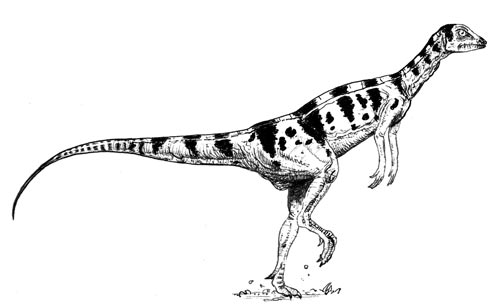New Late Cretaceous Ornithopod Species Named
Thescelosaurus assiniboiensis –Scampering Saskatchewan Resident
Canadian scientists have announced the discovery of a new dinosaur species, a relatively fast running, Late Cretaceous member of the ornithopods (a group of bird-hipped dinosaurs). The Maastrichtian stage fossil (66 million years old approximately), consists of parts of the skull, the pelvis and other portions of the skeleton. The new species has been named Thescelosaurus assiniboiensis after the region and the native Indians of that part of Canada.
Commenting on the discovery, Tim Tokaryk, head of Palaeontology for the Royal Saskatchewan Museum stated:
“It is small, but there are features in the cranium, the back end of the skull, and a few features in the pelvis that are quite distinct amongst all other known species of Thescelosaurus. So based on those central features, that’s what made it a new species.”
Thescelosaurus assiniboiensis
Perhaps no more than three metres in length, this biped had to have sharp senses and a turn of speed if it was to avoid becoming a meal for the large theropods that shared its Late Cretaceous home. With no obvious defences, running away may have been the best survival strategy for this relatively small dinosaur.
An Illustration of Thescelosaurus
Picture credit: Everything Dinosaur
Tokaryk who has also worked on Tyrannosaurus rex excavations for the museum added:
“We know there were small dinosaurs around at that time because we found fragments, we find teeth and such like that. But to find a partial skeleton of one individual, that makes it interesting and also makes it more useful to be able to identify it as a new species or a species in general.”
The specimen was collected from the Frenchman River Valley near Eastend in 1968 but was only identified recently when Caleb Brown, a master’s student from the University of Calgary, studied the bones for his thesis. This seems about par for the course as the specific name for the first Thescelosaurus specimen assigned to this genus is T. neglectus a reference to the fact that these fossils were not studied until twenty-two years after they were first discovered.
The formal study and naming of this new type of dinosaur helps scientists to piece together more information about specific ecosystems and how dinosaurs adapted to different habitats. Although, not as spectacular as some of its prehistoric cousins, animals such as the horned dinosaur Triceratops, or the giant duck-billed dinosaur Parasaurolophus, the research on T. assiniboiensis is helping scientists to understand more about the diversity of Late Cretaceous Dinosauria.
For models and replicas of prehistoric animals including Late Cretaceous ornithopods: Prehistoric Animal Models (Everything Dinosaur).


